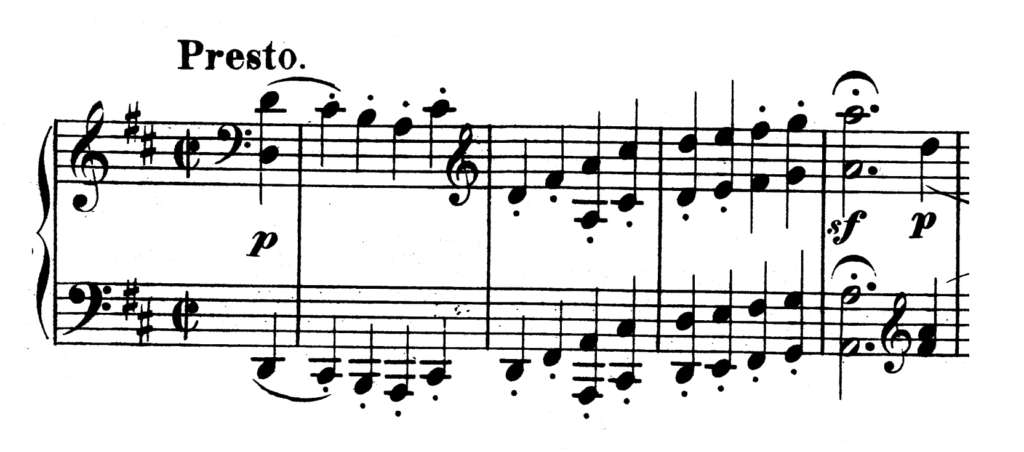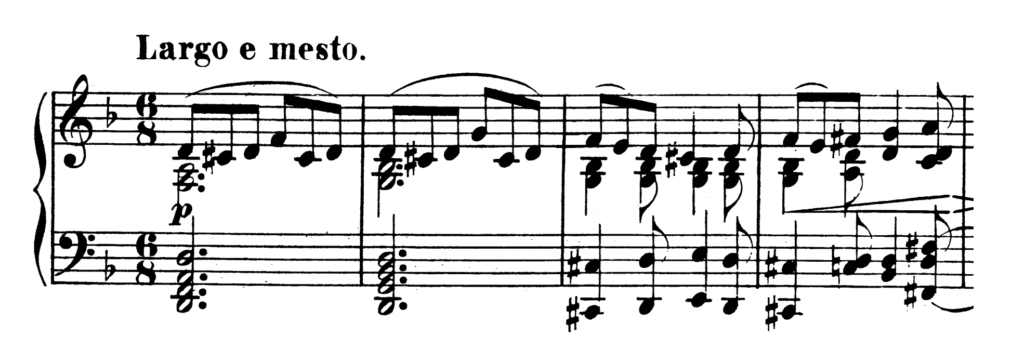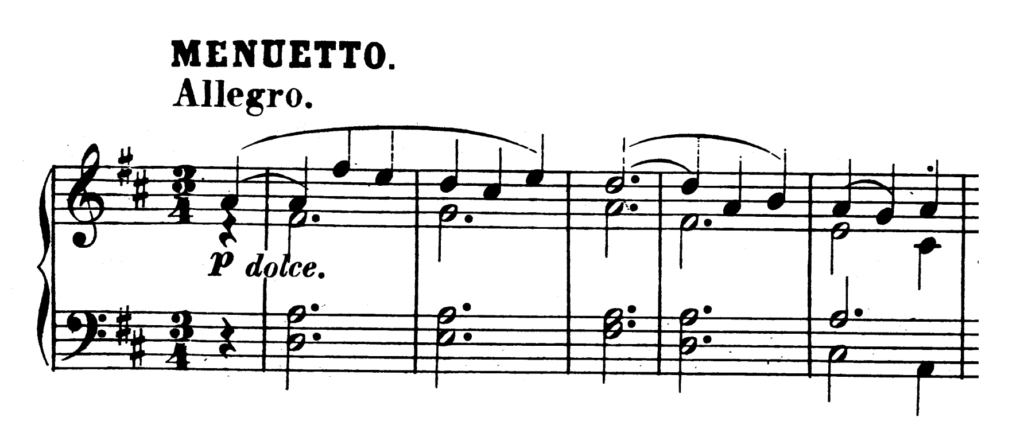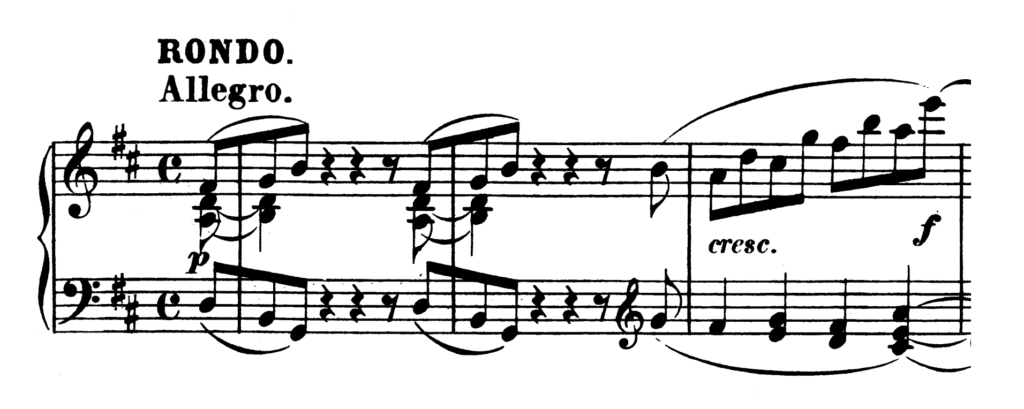Analysis
Contents
For the benefit of all pianists learning this work, we present to you a concise and easy to use analysis of Beethoven’s Piano Sonata No.7 in D major.
First Movement (Presto)
Form: Sonata Form. D major.
EXPOSITION:
Bars 1-11: First Subject in D major (tonic). The first subject begins with a four-bar phrase ending on dominant, Bar 5, followed by a six-bar phrase which ends with full close in tonic key.
Bars 11-23: Connecting episode. The connecting episode beings with a continuation of the first subject. Bars 17-23 are a variation and elongation of Bars 1-5, ending upon the dominant of the relative minor.
Bars 23-94: Second subject in B minor and A major. The second subject is divided into two parts, Bars 23-54 and 54-94. It commences with a theme in B minor, modulating to F sharp minor, A major, and E major, ending in A major; the second part of the second subject begins with a sentence of eight bars in A major, partly repeated, Bars 61-66, in A minor, followed by a new phrase (the bass of which is taken from the beginning of the first subject), which is developed at some length, giving place at Bar 88 to a passage in A major, which brings the second section to a close, Bar 94.
Bars 94-114: Coda. The Coda consists of some new material and slight reference to the first subject, for the most part on a pedal point.
Bars 114-125: Bars 114-25 form a passage leading to the repetition of the exposition, after which, with Bars 126-134, it leads to the development.
Double bar and repeat.
DEVELOPMENT:
Bars 135-185: The development, beginning in B flat major, chiefly refers to the first subject, the rhythm of the first five bars of which is the basis upon which most of it is constructed; compare rhythm of Bars 135-139 with Bars 1-5. It ends on dominant seventh, Bar 185.
RECAPITULATION:
Bars 185-195: First Subject in original key.
Bars 195-206: Connecting episode. The connecting episode, after a few bars, is altered to end in E minor.
Bars 206-276: Second subject in E minor and D major (tonic). The second subject re-appears, slightly altered and transposed; it begins in E minor and ends in the tonic key.
Bars 276-End: Coda. The Coda is slightly altered and transposed to end in D major.
Second Movement (Largo E Mesto)
Form: Ternary Form. D minor.
FIRST PART:
Bars 1-9: First subject in D minor (tonic). The first subject is of nine bars length, the first section of four bars being lengthened to five bars; it begins and ends in tonic key.
Bars 9-17: Connecting Episode. The connecting episode begins in D minor and ends in C major; it consists of two sections of four bars each.
Bars 17-26: Second Subject in A minor. The second subject, instead of being in the relative major, is in the dominant minor key. It begins with a sentence of four bars, which is repeated, varied, and elongated.
Bars 26-29: Coda. The Coda is formed form a part of the connecting episode, Bars 13-15.
Double bar. No repeat.
SECOND PART:
Bars 30-43: Part II consists of an episode in F major, modulating to D minor, and ending on dominant pedal point.
THIRD PART:
Bars 44-48: First subject in original key. The second of the first subject is omitted.
Bars 49-56: Connecting Episode. The connecting episode re-appears altered for the first four bars, after which it is transposed from C major to B flat major.
Bars 56-65: Second subject in D minor (tonic).
Bars 65-End: Coda. The Coda is entirely altered, the first two bars of the first subject appear in the bass, accompanied by a semiquaver (sixteenth note) figure in the treble, after which the bass rises chromatically from A natural to the octave above (omitting F sharp). The harmony abounds in chords of the diminished seventh. A pedal point on A (the dominant) and some slight reminiscences of the first subject brings the Coda to a close.
Third Movement (Menuetto. Allegro)
Form: Ternary Form. D major.
FIRST PART:
The First Part is in Simple Binary form.
Bars 1-17: First subject in D major (tonic). The first subject consists of a section of eight bars, ending with half-close on the dominant, followed by another section of the same length, ending with full close in tonic key.
Double bar and repeat.
Bars 18-26: Episode. The modulating episode consists of a three-bar subject answered (omitting the first note) at the fourth above.
Bars 27-45: First subject in original key. The first subject re-appears varied and extended. The first three bars are accompanied by an inverted pedal point on the dominant.
Bars 45-End of Part I: Coda.
Double bar and repeat from Bar 18.
SECOND PART:
Bars 1-33: Subject in G major (tonic). The first sixteen bars, which close on the chord of D, are repeated (Bar 17 to the end) with slight alterations, finishing on the chord of the dominant seventh of D.
Double bar.
THIRD PART:
First part. Da Capo.
Fourth Movement (Allegro)
Form: Rondo Form. D major.
FIRST PART:
Bars 1-10: First Subject in D major (tonic). The first subject consists of a section of four bars ending in dominant key, followed by a section of the same length, ending with full close in tonic key.
Bars 10-25: Episode. The episode begins with a phrase of two bars in D major, which is repeated three times, modulating to A major, in which key another phrase of four bars occurs, which is partly repeated, ending on dominant seventh.
Bars 25-34: First subject in original key.
SECOND PART:
Bars 34-56: Episode in B flat major. This episode in B flat major overlaps the last chord of the first subject. It begins with two bars of introduction suggestive of the commencement of the first subject, followed by a phrase, Bars 36-38, which is repeated in G minor and E flat major. A passage, Bars 42-46, in the latter key, ends on dominant seventh of F major; this is succeeded by some episodal modulation on the first subject and ending on the dominant seventh, Bar 56.
THIRD PART:
Bars 57-66: First subject (varied) in original key.
Bars 66-85: Episode. The episode begins like that in Part I; there is some fresh material at the end of it, based upon the rhythm of the first figure of the first subject.
Bars 85-94: First subject (varied) in original key.
Bars 94-End: Coda. The Coda is very original and contains many points of interest; note the rising sequence (Bars 94-97), the pause on the chord of the eleventh (Bar 100), the first subject figure in the bass against the chromatic runs in the treble (Bars 108-111), and the pedal point (Bar 108 to the end).










